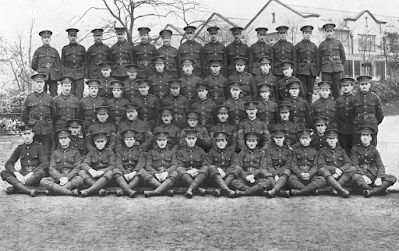The Great War has long passed out of living memory.
 |
| Receiving the message, 1915 |
The politicians who took Europe into that conflict and then prosecuted it, had pretty much all died by the end of the Second World, and now so have the men and women who were actively engaged on the battlefields, in the hospitals, and on the Home Front, as are those who were children during those four years.
They have left a vast set of memories, photographs, and heaps of other memorabilia which together with official documents help contribute to our understanding of the event and how people coped with it.
 |
| Tip-Top Tipperary Mary, date unknown |
And today I am looking at a photograph album of picture postcards from the period.
They were acquired “blind” by my friend David Harrop, and as well as offering up a snapshot of what the troops were sending home, give an insight on the person who collected them and placed them in the album.
We will never now know who that person was, but as many of them have a religious aspect I think we can begin to get an understanding of their character.
Some of the cards are sentimental, some a tad mawkish, and others express feelings shaped by the fighting.
So, Tip-Top Tipperary Mary, features a ghostly figure of Mary looking down on a dying Irish soldier, while the Rosary likens the object to a “string of pearls” which are counted over and over again “everyone a part”.
Others are more direct like the Chaplain tending British War Graves, while two soldiers look on lost in their own personal reflections.
And then there is the posted message to a Mrs. Tavernor of 1 St Mary’s Road, Moston.
 |
| From Harry Dale, 1915 |
It was sent by Harry Dale and is dated July 14th 1915. The card was one of those issued by the British Army consisting of a series sentences about the postee, from “I am quite well” to “Letter follows at first opportunity” to “I have received no letter from you {lately, for a long time}”
Leaving the servicemen to delete the sentences which were not applicable, and add only a date and signature, with card instructing the sender that “Nothing is to be written on this side except the date and signature of the sender. Sentences not required may be erased. If anything else is added the postcard will be destroyed”.
 |
| 17th Battalion Manchester Regiment, circa 1914-15 |
As it happens we know a bit more about Harry Dale, who was killed at Gallipoli in July 24th 1915, aged just 18.
Four years earlier he had been living with his parents and siblings at number 9 St Mary’s Road, and described himself as a clerk, which may mean he was the Charles Dale, who is recorded on the Manchester Pal’s Roll of Honour as serving in Platoon XI of the 17th Battalion of the Manchester Regiment.
I can’t be entirely sure because Mr. Dale appears to have favoured different variations of his given name.
 |
| The album, date unknown |
On the census returns and at his baptism at the Methodist Chapel in Newton Heath, he is listed as Charles Harrison Dale, while the military records at his death have him as Harry Dale, and he enlisted as Charles.
But I will just have to check the deployment of the 17th Battalion, just to check it was at Gallipoli in 1915.
But I can't think Charles had enlisted before 1914, as he was only 14 in 1911.
So, not perhaps the biggest mystery of the Great War, but none the less one of those little intriguing ones from that long forgotten picture postcard album.
 |
| Chaplain tending British War Graves, date unknown |
Location the Great War
Pictures; picture postcards from a photograph album, date unknown, from the collection of David Harrop, and Platoon XI, 17th Battalion of the Manchester Regiment, Manchester City Battalions Book of Honour, 1916
No comments:
Post a Comment